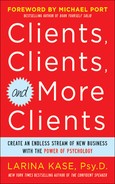Use Metaphors to Engage Emotion
,One of the most powerful ways to reach people on a deep level is through metaphors. In marketing ourselves and our services, our ultimate goal is for someone to hear something and think, “Wow, I need that.” Or “Wow, my clients need that.” This sense of needing something is typically unconscious. We simply experience an emotional reaction to something but are not sure why.
In the book Marketing Metaphoria, Harvard Business School professor Gerald Zaltman and coauthor Lindsay Zaltman discuss the power of deep metaphors. They explain that deep metaphors and emotions are closely linked because both are universally experienced on an unconscious level and seem to be a combination of being hardwired in our brains and stemming from our experiences. In their research, which consisted of conducting 12,000 interviews of consumers of products and services in more than 30 countries, seven fundamental deep metaphors accounted for 70 percent of all deep metaphors:
1. Balance. This may include physical balance (such as being on or off center), psychological balance (such as feeling on or off track), and social or moral balance (feeling that something is fair or unfair). Positive emotions associated with feeling balanced may include feeling at peace, calm, serene, satisfied, and comfortable.
2. Transformation. This has to do with something changing to something else. It may be something that happens in nature, such as a tadpole turning into a frog, or with a phase in life, such as going from being an employee to being a business owner. Someone who shows a transformation metaphor may value excitement, adventure, newness, creativity, and change.
3. Journey. This is the process of moving from something to something else. It may be fast or slow, short or long, easy or hard, rewarding or grueling, and so on. Feelings and values involved in a journey metaphor may include curiosity, interest, intrigue, or leadership.
4. Container. This is the sense of keeping something inside (or keeping something out). A container may be associated with a positive emotion, such as feeling cozy and secure, or a negative emotion, such as feeling trapped.
5. Connection. This is our sense of relatedness and belonging with others. Connection may be desirable or undesirable when someone does not want to be associated with something or someone. Positive emotions associated with the connection metaphor include a sense of fitting in, support, understanding, relationship, unity, and bond with others.
6. Resource. This is the most fundamental of deep metaphors because it is linked with our survival. Feeling as though we lack resources is likely to be linked with fear and panic, while feeling as though we have resources is likely to be linked with comfort (although not necessarily contentment).
7. Control. This is related to the feeling that you are in charge of your life. Some people have a higher need for control while others may be more flexible. Feeling out of control is often associated with anxiety, whereas feeling in control is often associated with feeling organized, powerful, influential, and disciplined.
How do you know which deep metaphors are important?
Determining which metaphors to evoke and what language to use entails listening. Take note of the way in which people speak, the imagery that is evoked, and what patterns you notice.
Let’s say, for example, that you’re a financial planner and you notice that your prospective client has said, “I am the breadwinner,” “Cash burns a hole in my pocket,” and “I need to pay for my son’s college.” This individual appears to view money and therefore financial planning as a resource. Understanding this metaphor enables you to speak about how you help your clients manage the resource of money. Knowing that a lack of resources is associated with fear and panic, you can choose to discuss how you work with clients to select secure investments. Let’s say that another financial planning prospect says, “Saving has been an uphill battle,” “It is tough when the stock market is down,” and “I’m moving up the corporate ladder.” Observing this type of language enables you to see that this person sees their financial planning needs as a journey. As such, you may evoke the image of savings accumulating like a mountain, or how you help clients take the burden of not knowing what to do off of them so they no longer feel like they’re pushing a boulder up a mountain.
The other way to determine what metaphors resonate with your prospective clients or referral partners is to test them out. Select the top few metaphors that you believe are most relevant and use language associated with each. Observe people’s responses.
One of my clients, Jarrod, a career coach who helped executives in transition, did this with his clients. Based on his experience, he predicted that the metaphors most relevant to his clients were transformation, journey, connection, and control. He used language such as “career transition” and “career change” to capture the transformation metaphor. For journey, he spoke of “the long trip,” “crossing into new fields,” and “as you travel through your career.” For connection, he said things like “the right fit,” “the relationship between your skills and job,” and “hitting it off with colleagues.” For control, he said things like “be in charge of your career” and “get back in the driver’s seat.” He found that his clients responded most favorably to the journey and relationship metaphors. Even more interestingly, he was able to see how male and female clients, clients of different ages, and clients in different fields responded differently. He used this knowledge to shape his marketing materials, including the language and imagery he selected. He also used it to determine the stories he would tell, and he selected different stories to share based on who he was speaking with and in what setting.
Now that you’ve attracted attention and engaged emotion, you want to show how you’re the go-to person, the credible expert in your field. Let’s go there now.
